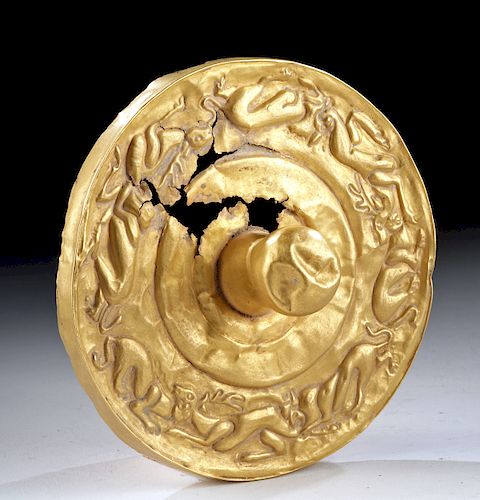Rare Scythian Gold Repousse Lid w/ Animals - 98.7 g
Lot 98a
About Seller
Artemis Gallery
686 S Taylor Ave, Ste 106
Louisville, CO 80027
United States
Selling antiquities, ancient and ethnographic art online since 1993, Artemis Gallery specializes in Classical Antiquities (Egyptian, Greek, Roman, Near Eastern), Asian, Pre-Columbian, African / Tribal / Oceanographic art. Our extensive inventory includes pottery, stone, metal, wood, glass and textil...Read more
Estimate:
$6,000 - $9,000
Absentee vs Live bid
Two ways to bid:
- Leave a max absentee bid and the platform will bid on your behalf up to your maximum bid during the live auction.
- Bid live during the auction and your bids will be submitted real-time to the auctioneer.
Bid Increments
| Price | Bid Increment |
|---|---|
| $0 | $25 |
| $300 | $50 |
| $1,000 | $100 |
| $2,000 | $250 |
| $5,000 | $500 |
| $10,000 | $1,000 |
| $20,000 | $2,500 |
| $50,000 | $5,000 |
| $100,000 | $10,000 |
| $200,000 | $20,000 |
About Auction
By Artemis Gallery
Sep 26, 2019
Set Reminder
2019-09-26 10:00:00
2019-09-26 10:00:00
America/New_York
Bidsquare
Bidsquare : Exceptional Day 1: Antiquities & Asian Art
https://www.bidsquare.com/auctions/artemis-gallery/exceptional-day-1-antiquities-asian-art-4437
Day 1 of an important 2-day auction featuring exceptional, museum-worthy examples of Egyptian, Greek, Etruscan, Roman, Viking, Russian, Near Eastern, as well as Asian Art from China, Japan, Thailand, Vietnam, Burma and India. Artemis Gallery info@artemisgallery.com
Day 1 of an important 2-day auction featuring exceptional, museum-worthy examples of Egyptian, Greek, Etruscan, Roman, Viking, Russian, Near Eastern, as well as Asian Art from China, Japan, Thailand, Vietnam, Burma and India. Artemis Gallery info@artemisgallery.com
- Lot Description
Western Asia, Scythian culture, ca. 4th to 3rd century BCE. A fascinating gold lid (94% gold, equivalent to more than 22K), quite large and presenting a circular form with a large central knob. Surrounding the knob is a continuous frieze of 8 ibexes - several arranged in pairs and facing one another with intertwined antlers as if fighting or playing - skillfully delineated in repousse. The lid's circular shape suggests that it may have belonged to a special pyxis - a lidded cylindrical container used to hold precious jewelry, cosmetics, or special ointments. Size: 5.25" in diameter x 2" H (13.3 cm x 5.1 cm); weight: 98.7 grams; gold quality: 94% gold, equivalent to 22K+
The Scythians are famous for their goldwork, and rightly so; hoards of their treasures have been found throughout eastern and central Europe and western and central Asia. These hoards may represent gifts that were made to foreign rulers, votive offerings, or treasures buried and forgotten. Other gold artifacts from this culture are found in their incredibly rich graves. According to Scythian tradition, warriors (both male and female) were buried alongside their servants and horses, with weapons, harnesses, and personal adornments to provide for them in the afterlife.
Provenance: private East Coast, USA collection; ex-private Japanese collection, acquired in 1980's
All items legal to buy/sell under U.S. Statute covering cultural patrimony Code 2600, CHAPTER 14, and are guaranteed to be as described or your money back.
A Certificate of Authenticity will accompany all winning bids.
We ship worldwide and handle all shipping in-house for your convenience.
#149163Cracks and losses to upper face as shown. Indentations to the circular face, borders, and knob commensurate with age, and a few stains on the verso. The zoomorphic imagery is still quite strong.Condition
- Shipping Info
-
All shipping is handled in-house for your convenience. Your invoice from Artemis Gallery will include shipping calculation instructions. If in doubt, please inquire BEFORE bidding for estimated shipping costs for individual items.
-
- Buyer's Premium



 EUR
EUR CAD
CAD AUD
AUD GBP
GBP MXN
MXN HKD
HKD CNY
CNY MYR
MYR SEK
SEK SGD
SGD CHF
CHF THB
THB














